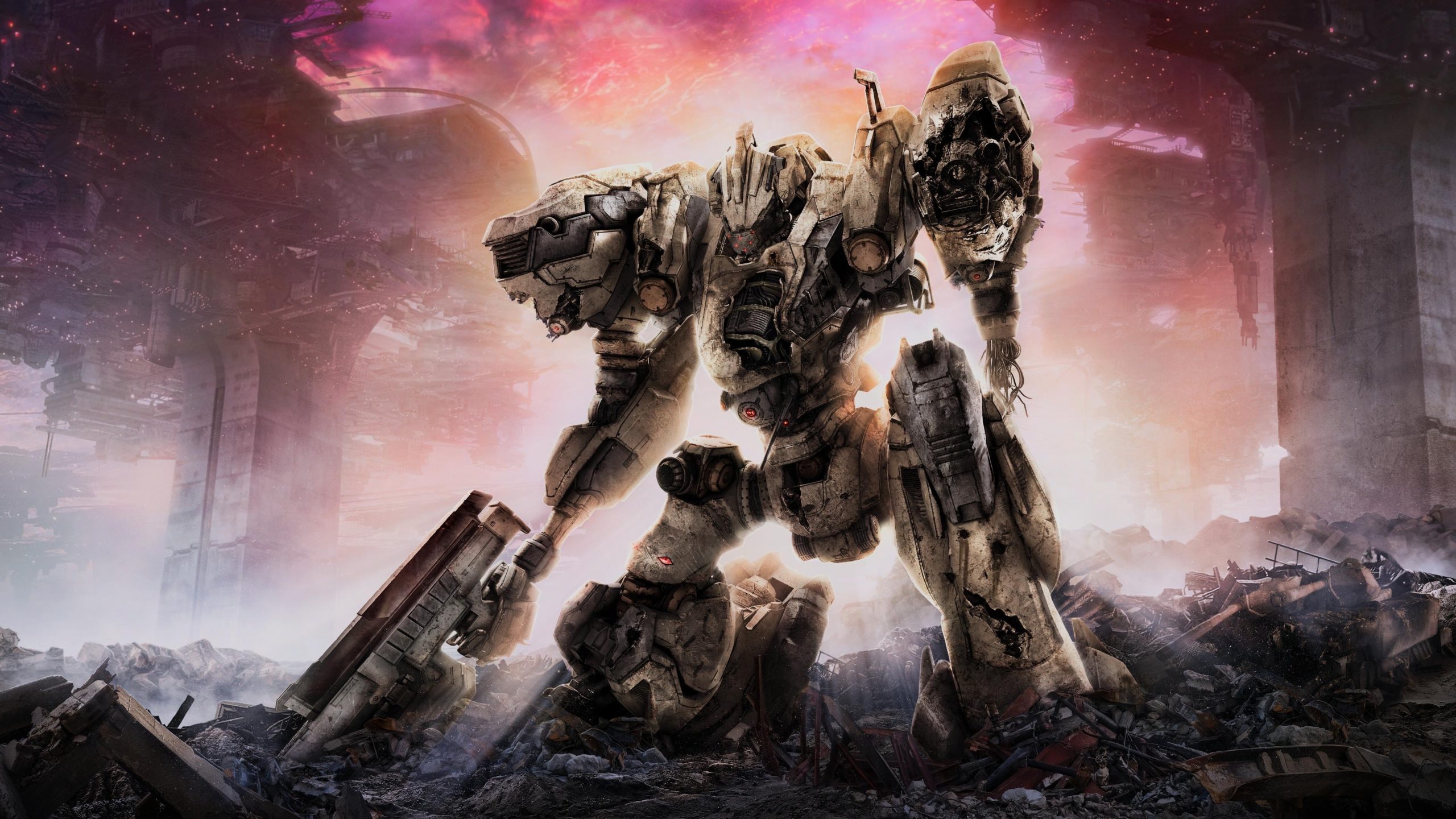Armored Core VI: Fires of Rubicon is the latest title by FromSoftware. A team now synonymous with bringing arguably one of the biggest shifts in genre since the FPS, as the ‘Soulslike’ is at a mainstream peak after the launch of Elden Ring. And that’s about it in terms of comparisons but FromSoftware have sharpened one tool along the way with their triumphant return to the AC series: their design philosophy.
Sure, FromSoftware games are often unflinching and lack compromise. However, it’s not about hard games being hard, but rather showcasing and exploring worlds wrought with nihilistic intent, that the battle and triumph are solely your own. Giving the player their own sense of purpose in a grim yet captivating delivery. Armored Core VI is just that, dialled up to 11, stinking of burnt fuel and singeing your pupils with distinct and epic clashes between metal titans, making Eikons look like Nay-kons by the end of it. So how has FromSoftware succeeded in bringing mechs back into the spotlight? Let’s get into it.
Gundam? More Like Goddamn
You play as Pilot 621. An augmented human in the grasp of Handler Walter, as you do his bidding as a freelance Mercenary. At the start, you infiltrate the planet of Rubicon 3 – a mining planet – to assist in corporations’ domination of the flow of Coral. Coral is a natural resource that has recently resurfaced after nearly destroying the planet a decade prior. The game describes it as having the ability to change the quality of human life exponentially, which you’ll find out more about later in the game.
You quickly garner a reputation, with all the factions that are extracting what’s left giving you more work to do. But as the mystical properties of Coral become apparent, you are thrust into a situation far bigger than the Mech you pilot. Often is the case with FromSoftware games, the story has an underlying density that you often have to pry into. Armored Core VI is more front-facing with its themes, overlapping ideologies and opposing characters, and usually all of them are after a great power.

All Dialogue is presented through audio codec messages, with a very dry matter-of-fact delivery. It really lends itself well to the desolate and emotionless actions of all the characters in the game. Series veterans may be more acquainted with augmented humans, and seeing as you are one, you do feel like a cog in the oppressive machine. There’s a dark mystery bubbling, with multiple voices coming at you to choose how you deal with Rubicon 3. And with multiple endings, New Game+, you’ll be able to explore where the story can take you. The game bludgeons you with atmosphere from the jump, and whilst the delivery of the story still isn’t its finest, it does an excellent job of retaining intrigue.
Mechanical Dynamite
The story wasn’t the main motivator for blazing through the game with my boosters though, as the gameplay just didn’t stop being incredible. You are the pilot of a bipedal mech (Armored Core, AC for short), fit with an assault rifle, plasma sword, homing missiles and your boosters to get about the gargantuan-looking levels. The shoulder buttons act as each weapon, with an aim assist by default. This lends itself to frenetic combat encounters against other weaponised machinery, as you are boosting around and firing at will causing a spectacle of damage.
Your HUD on first impressions can feel overwhelming by showing your health, boosters, stagger bar and weapons capacity. However, with time you grasp it and with audio cues telling you if you’re low on health, or ammo, you quickly feel like a space cowboy. The structure is archaic at this point as you go on Sorties (Missions), with a brief that usually leads to you blowing up other mechs. Not since Metal Gear Solid V: The Phantom Pain have I played a game that drops you in and out of levels that usually take 3-5 minutes to beat, then go straight back to base.
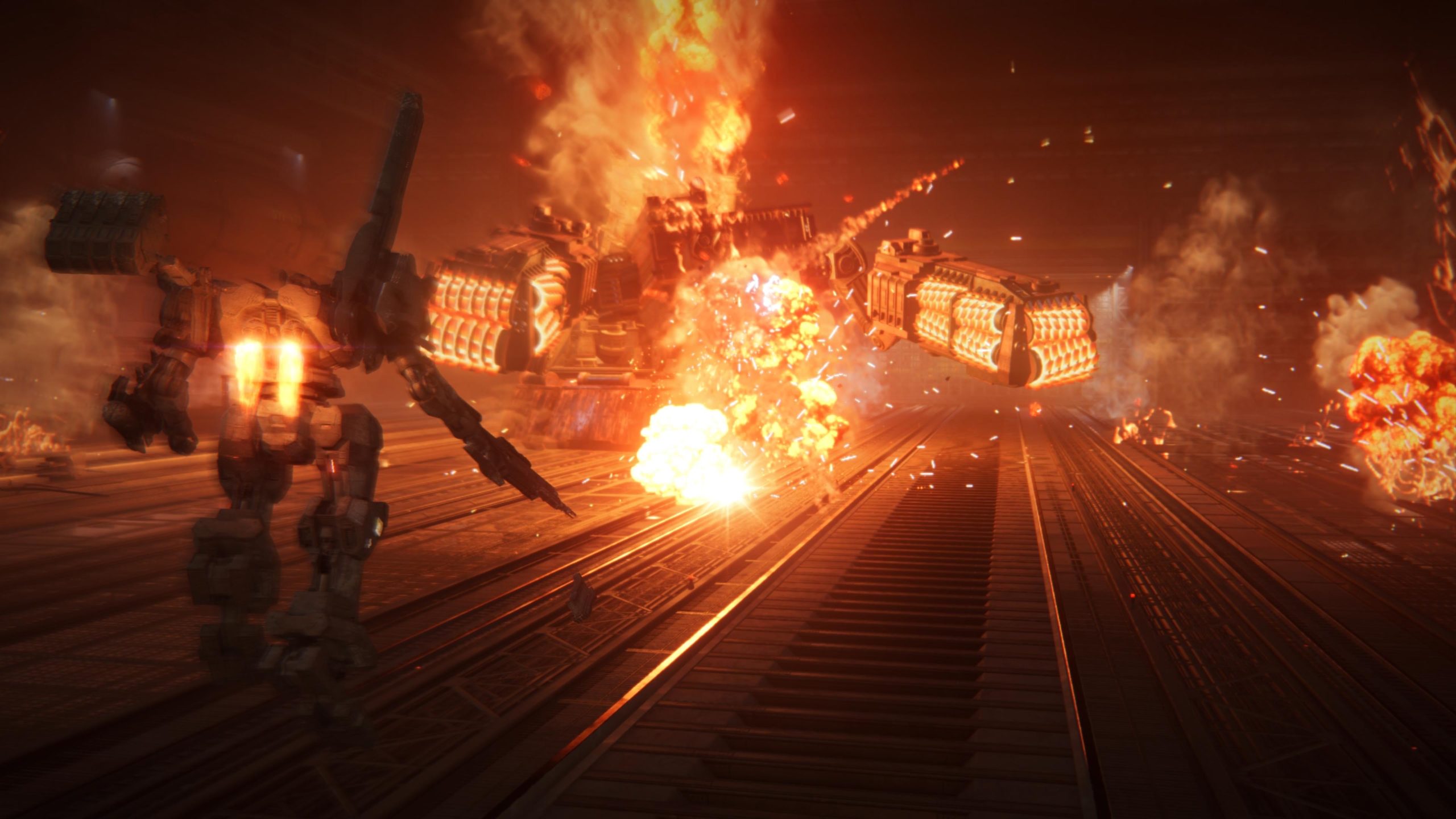
Nevertheless, there’s something addictive about the format. Levels feel doable and don’t wane in attention as the combat is blistering throughout. Missions don’t really veer away from destroying enemies or collecting data (whilst destroying enemies) if you want to be reductive, but the context of the story poses the same challenge with a different lens, and I simply couldn’t get enough of it. Once I got to grips with how the game ticks, I felt powerful and it fully delivers on the mech fantasy. This is just the tip of the iceberg though, as it gets so much deeper.
Build-A-Mech Workshop
If you’re not gelling with the default build, don’t worry, there’s more than one way to skin a mech. Armored Core VI has a ridiculous amount of customisation options, that you can buy at the Parts Shop. Head, Arms, Body, Legs can all be changed. The four weapon slots have a long list of different munitions that do different types of damage, all with their own pros and cons. You can also adjust the guts of the mech with generators (improve battery usage), boosters and FCS to help weapon ranges.
It’s overwhelming to start and as more of the game opens up you will get even more options to choose from. However, the in-game economy is so forgiving. You can sell back parts for the price you paid, already completed missions are replayable and you can also test your AC on its abilities before taking it on the battlefield. Essentially, the only real cost is your time and if you’re enjoying the gameplay so much you can take great pride in the in-depth tinkering the game offers.
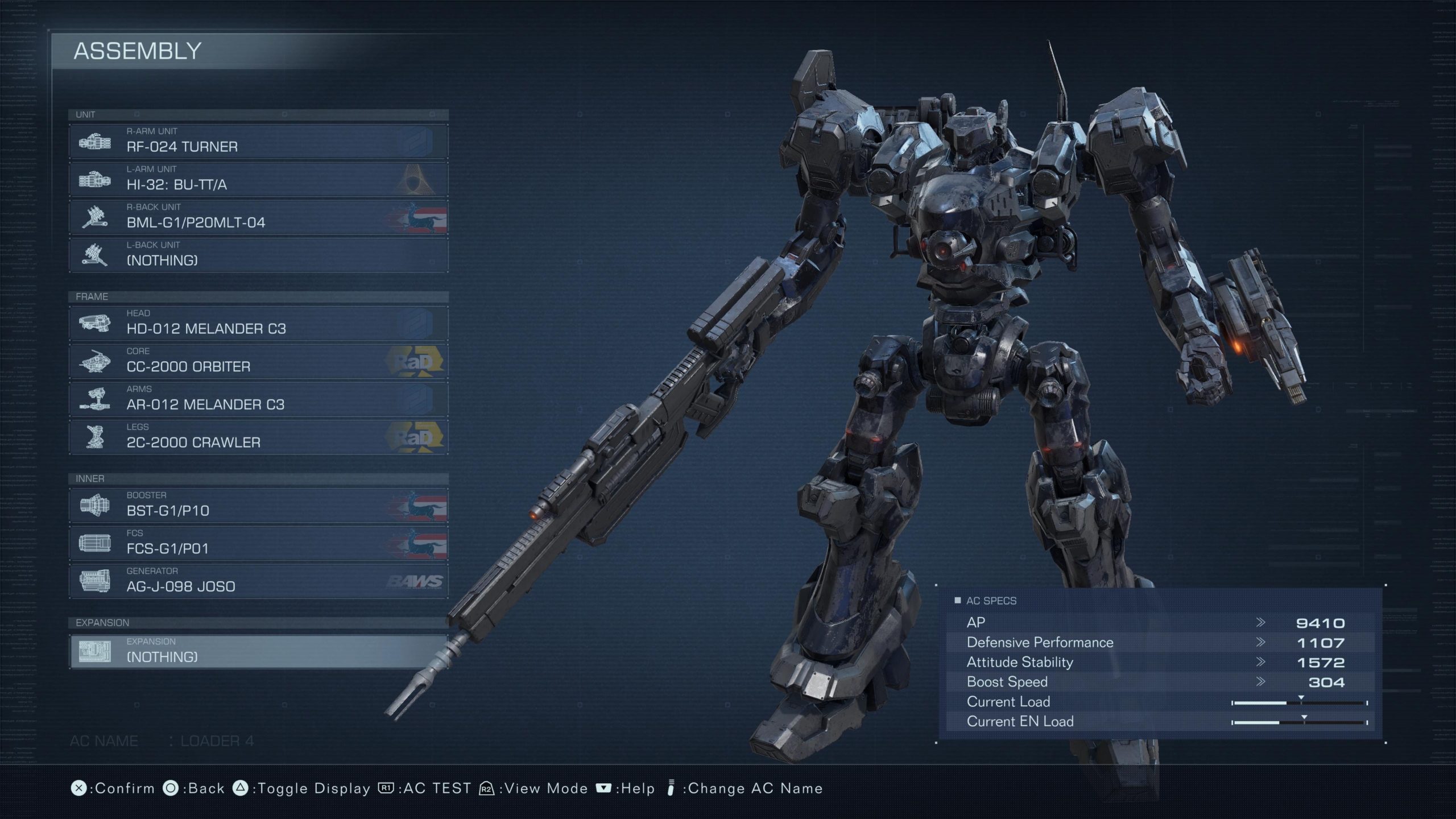
The main to your AC I think you can do is the legs. You have bipedal, reverse joint, tetrapod and tank. All of them have their own strengths and weaknesses in combat and they all feel so intuitive to use that there really isn’t just one way to play the game, making it feel infinitely replayable for the most part. Outside of the story and shop, you have an Arena mode to fight other ACs and Nest that acts as the online component where you can do PVP with other players. I didn’t try it out because, like the Soulsborne series, I usually lose embarrassingly, though I can imagine it’s a massive draw for some people who are considering buying.
The End of Rubiconion
There’s a specific aspect of the game that post-launch has got social media in a frenzy with its difficulty, and that’s the boss battles. There are a lot of bosses to wage war with if you count some of the smaller-scale fights during the sorties. However, it’s the end-of-chapter tussles that are the true skill-check moments. They are unwavering and are probably the closest to FromSoftware’s previous franchises.
I have a personal love/hate relationship with the boss fights. To start with the positives, they are true spectacles amongst a plethora of spectacles. Unique in design and extremely tough, each boss has a place in the world that peels back the plot, driving my motivation to continue. Moreover, the moment you solve their move sets and counter accordingly, you feel powerful and the adrenaline is hard to shake. But that is a question of when you solve the battle, or even if. They come across a lot more rigid compared to the freedom of execution seen in the rest of the game.
More often than not, it was more of a case of using the right weapons and the correct strategic manoeuvres to win the fight, instead of having the sheer ability to conquer. On the bright side, checkpoints are very forgiving, and during the fail screen you can swap out any parts of your loadout to see fit. Unfortunately, the store is unavailable during a mission but they’re not too long to beat if you feel the need to pick up a new specific gun to beat the boss.
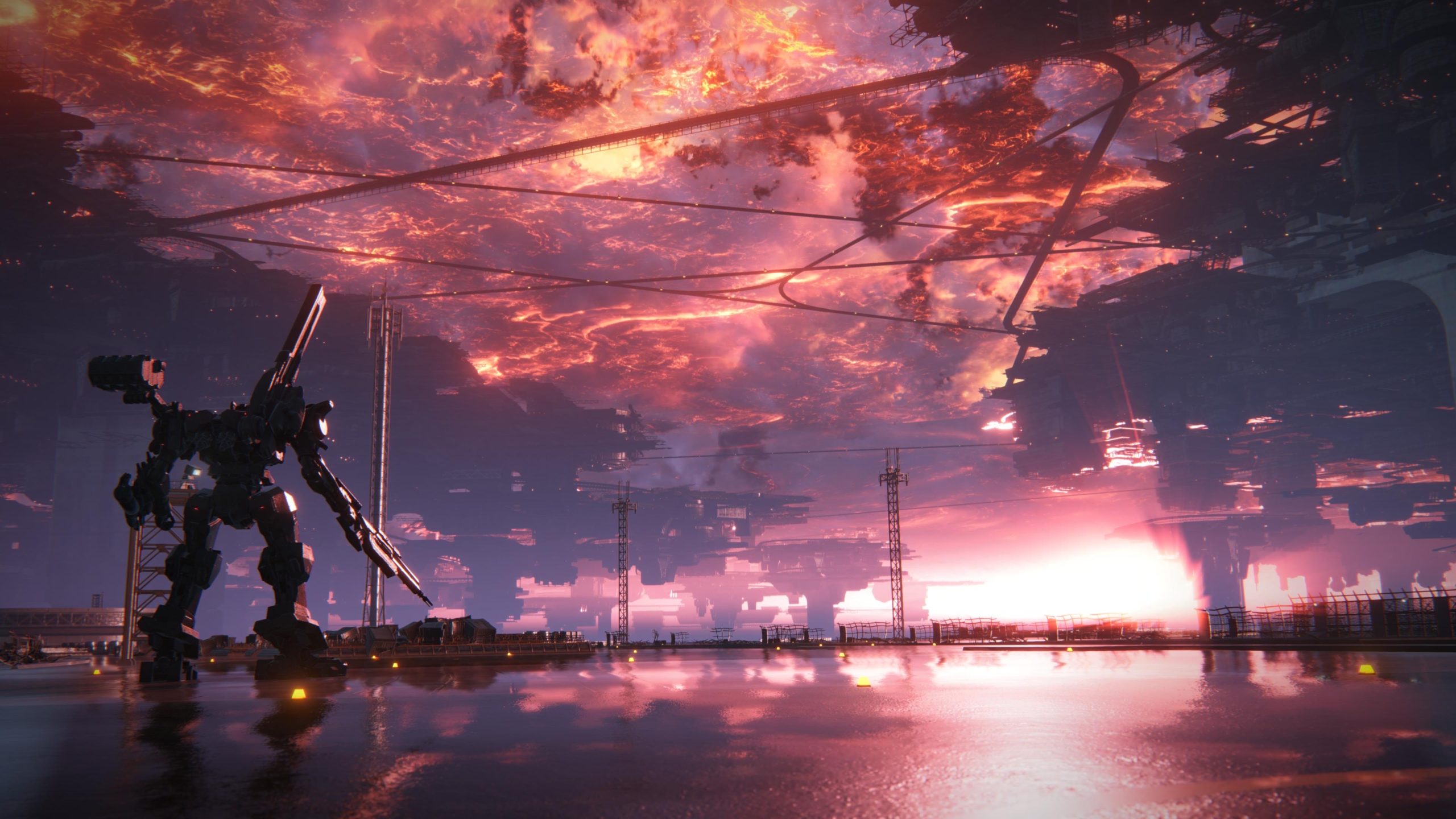
Iron Giants
Rubicon 3 is a barren planet with an imposing amount of machinery and steel architecture that makes your AC look insignificant. The level designs exude a cold and inhuman feeling that’s only bolstered by the often curt dialogue I previously mentioned. Given the story, I couldn’t tell if the maps were covered in snow or ash from the catastrophic event, but both evoke desolation.
The white of the planet, the greys of the mechanical necropolis and the burning clouds of the skyboxes create a contrast of colours filled with dread and melancholy. The ACs and other weaponry are so detailed in their execution. Showing off every piston, gear and motor unit, I found myself lost in the minutiae when developing my AC.
The art direction is overall sublime and the set pieces and cut scenes are awe-inspiring, but some may take umbrage with the visual fidelity in-game. This is a full-priced title amongst other AAAs this year and Armored Core VI isn’t pushing the graphics. Whilst the scale of the levels is probably the biggest I’ve played they are empty, even if intentional.
Sound design is on point however as every hiss of your AC, clash of metals or explosion of the enemy empowers the chaos that you’re playing. The soundtrack is minimal and brooding, perfectly matching the tone of everything else. Armored Core VI is stand-offish in the overall direction and it plays so well given the brutal aspect of the plot and characters.
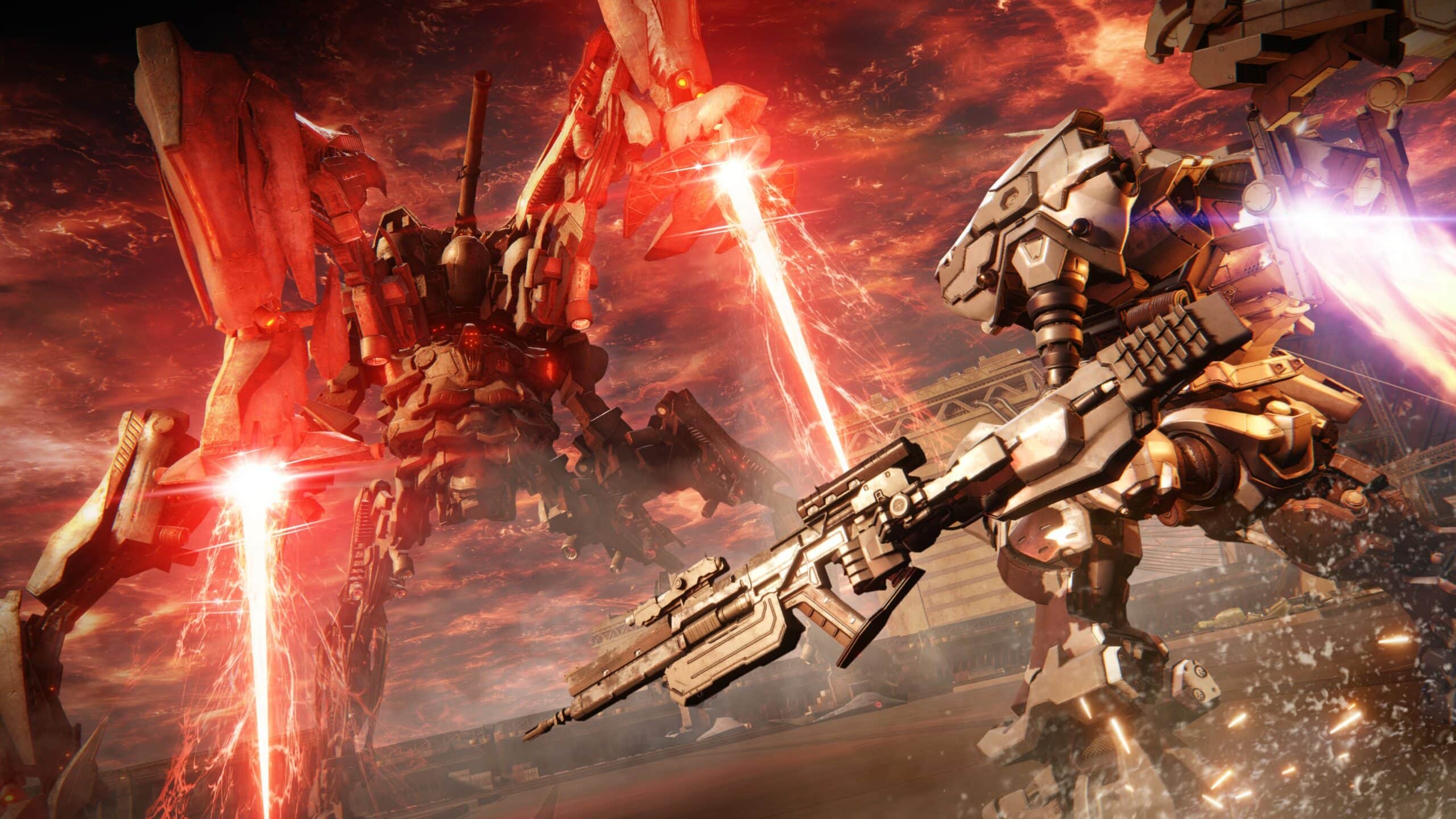
Planet Destroyer
I’m new to the Armored Core series, having found my love of FromSoftware titles after Bloodborne and playing every subsequent game I could get my hands on for modern consoles. So playing through Armored Core VI, a game so different to what I’m used to seeing from the developers at this point, I can really get behind why the franchise is so beloved.
The world-building is more direct, dense and alluring. The gameplay is sharp, intuitive and overall exceptionally fun. Fusing the breakneck pace and tactile manoeuvrability of the gunfights feels supremely engaging, and the bite-size mission structure just adds to the addictive nature of doing just one more mission.
I’ve not gone in-depth with every mode, but there is a lot to chew on. Whether it’s Arena, Online PVP, Testing out your AC, or getting all the endings for the story, there’s so much to learn and play through that it’s just exciting. This will be a hard game for some and there are definite parameters on how you should play, but it’s so rewarding when you get to grips with everything Armored Core VI has to offer. I can’t recommend it enough if you love mechs, or FromSoftware games, or even blistering action games.
Armored Core VI: Fires of Rubicon is an incredibly dense mech action title. Every facet has multiple layers that force you to chip away piece by piece, making the game so rewarding when you put in the work. The gameplay is laced with adrenaline and wholly addictive, with a mission structure that only indulges it, making Armored Core VI hard to put down. With a plethora of modes to get lost in, extensive customisation and impeccable world-building, this is another incredible title by FromSoftware.

Armored Core VI: Fires of Rubicon is available now for PlayStation 5 (review platform), PS4, Xbox One, Xbox Series X|S and PC via Steam.
Developer: FromSoftware
Publisher: Bandai Namco
Disclaimer: In order to complete this review, we were provided with a promotional copy of the game. For our full review policy, please go here.
If you enjoyed this article or any more of our content, please consider our Patreon.
Make sure to follow Finger Guns on our social channels. Twitter, Facebook, Twitch, Spotify or Apple Podcasts – to keep up to date on our news, reviews and features.
